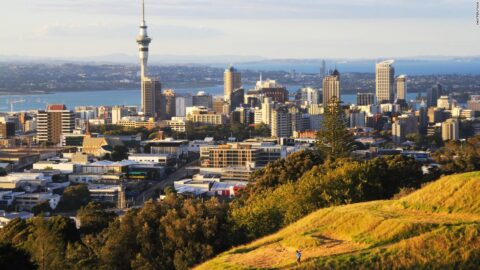However, travel there from July to October, the moderate months between the extremes of the wet and dry seasons, and you’ll witness one of Mother Nature’s crowning glories.
The 62.1-mile-long river is in Colombia’s Serranía de la Macarena national park, in the province of Meta, and is known as the “River of Five Colors.”
This “liquid rainbow” — as it is also called — is one of the South American country’s most spectacular natural wonders, thanks to its vivid colors.
The bed of the river sports bright red, yellow, green, blue and black for the few months that conditions are right. Although the colors can be viewed from as early as mid-May and sometimes into December, they are brightest during June and November.
The colors are produced during the reproductive process of the aquatic plants in the river, which are called Macarenia clavigera, a species of the riverweed family Podostemaceae.
During the wet season, the river runs fast and high, meaning the sun cannot hit the riverbed’s plants. During the dry season, there is not enough water to support the plants. The seasons rarely vary, so visitors wanting to catch sight of the spectacle have to head to the national park during those months that the bloom is most visible.
The phenomenon happens nowhere else in the world. The area itself is a hotspot for biodiversity, where the Andes mountains and the Amazon and Orinoco basins converge — and is home to many endemic species.
Preserving the river

The river seemingly runs red when the riverweed is in bloom.
Thomas O’Neill/NurPhoto/Getty Images
Prior to the pandemic, thousands of tourists flocked to see the spectacle every year, which had raised concerns amongst scientists that the river may be threatened by overtourism.
Flavia Santoro, head of ProColombia, the country’s tourism board, says that measures had to be taken to protect the area — so large was the influx of visitors. The agency “severely restricted development” of tourism infrastructure in La Macarena, the nearest small town to the national park, as well as capping the number of tourists allowed in at 200 per day.
There were so many tourists visiting the region that in spite of the cap environmental authorities closed the destination in December 2019 to protect the river. The closure was then extended due to the pandemic.
For 18 months, until its reopening in June this year, Caño Cristales did not receive one single visitor.
The effect, biologists say, has been been beneficial for the region.
Faber Ramos, a park ranger and eco-tourism coordinator in the Colombian national park system’s Orinoco region, says the pandemic has had a “positive effect” on the river’s health and that there was now a greater presence of fauna.
At its peak, around 15,000 tourists were visiting Caño Cristales per year, and the tourism board was projecting the number to continue growing.
Colombia had been experiencing a solid yearly growth in tourists visiting the country, following the signing of the peace agreement with FARC guerrillas in 2016, which officially ended more than 50 years of civil war.
The signing saw millions of international tourists flocking to explore the country, as well as Colombians themselves traveling to areas that had previously been inaccessible due to the war — such as Serranía de la Macarena national park. Between 2017 and 2018 alone, the country saw visitor numbers grow by 38%.
Balancing visitors and the fragile environment

A long closure to tourists during the pandemic has been beneficial to Caño Cristales.
Thomas O’Neill/NurPhoto/Getty Images
The growth was hugely beneficial for the tourism industry and small towns that suddenly found themselves catering to tourists’ demands for local guides, accommodation and food, but proved problematic for environments that had lain almost untouched for half a century.
For decades, tourists — even Colombian ones — stayed away from Caño Cristales as it was in a region controlled by FARC guerrillas.
“The area is a hotspot of biodiversity,” says Carlos Lasso, senior researcher at the Humboldt Institute, a Colombian body in charge of the nation’s biodiversity.
“It is where biologic elements of the Andes, Amazon and Orinoco basins converge. There are many endemic species and species of restricted distribution. The region of the Serranía de la Macarena has been a place of war for many years…[but now] deforestation in the region is advancing at an alarming rate.”
Deforestation is one of Colombia’s most pressing problems, with more than 40 soccer fields worth of trees logged every day, and the area of La Macarena is no exception.
Deforestation affects the patterns of rainfall, and the area has seen less rain, meaning the water of Caño Cristales can turn from clear to a murky brown, which could eventually kill off the Macarenia clavigera.
And as the country reopens, the challenge for Caño Cristales will be to not exceed the ecosystem’s capacity for visitors.
“It is a difficult area to protect,” Lasso said, “as it is so far from any city.”
“Although the government is doing well, there is always room for improvement,” he said, adding that more park officials were needed to protect and monitor the region.
New opportunities
The pandemic has provided an opportunity to scale back the number of visitors, and prioritize the area’s health.
Lasso is pragmatic; the river brings in much needed money to the region and locals have suffered a huge loss of income.
The recent reopening of Caño Cristales also includes 10 new ecotourism trails, with strict operating times of 7 a.m. to 4 p.m.
There are designated swimming areas in the river. However, visitors are not allowed to swim wearing sun lotion or bug spray, as the plants are sensitive to the products’ chemicals.
The entry of single-use plastics, such as bags, bottles, straws, containers, plates and cutlery is also prohibited.
Not only do tourists travel to see the river, but the abundance of wildlife is a draw for the crowds. Turtles, iguanas and aguilas — Colombia’s national bird — are just some of the local species that can be spotted in the Serranía de la Macarena national park, home to more than 400 bird species.
Despite the challenges, Lasso is hopeful. “More young Colombians are learning about the environment, and how to preserve it.”
If you go
Although the cap is still far lower than it was pre-pandemic, the national park is allowing a handful of visitors in every day, so make sure to book tours in advance.
Most tours range from two to four days and will take you to other areas of the park, which are well worth seeing. The closest town to Caño Cristales is La Macarena. It’s not possible to camp within the park, so visitors have to “commute” from the town, which has basic accommodations.
Make sure you bring plenty of cash — ATMs in the town are limited, and don’t always work. You’ll need your yellow fever vaccination, as occasionally visitors are asked to show their certificate at La Macarena airport, and you’ll also need to take anti-malaria tablets.




Recent Comments